#lumad schools
Explore tagged Tumblr posts
Text
Davao Today on Facebook:
JUST IN: THE cases of human trafficking against Talaingod Datu Benito Bay-ao and slain Lumad school teachers Chad Booc and Jurain Ngujo II in relation to their custody of Lumad students in Cebu in 2021 were dismissed by Tagum RTC Branch 2.
Judge Jimmy Boco ruled that the prosecution, in this case, police authorities, failed to prove the allegation that Bay-ao, Booc, and Ngujo exploited the Lumad students to join the New People's Army.
via Kath M. Cortez/ DavaoToday
2024 Jun. 24
#junk anti terror law#save our schools#philippines#indigenous rights#lumad#extrajudicial killings#state violence#red tagging#afp-pnp
3 notes
·
View notes
Text
in honor of that stupid new deped order...
#gonna change my cover to something special :)#it is so unnecessary man lmfaoo what even are their priorities at this point. 'make it less cluttered' the curriculum is much much more-#cluttered than the classroom decorations could be. how about you focus on that <3333333#make sure to also prioritize the decluttering of the classrooms of the Lumad tribes!! OH WAIT you guys have been shutting their schools-#down since 2016 because tHe cOmMieS aRe rEcRUItiNg you fucking vile fucking rancid red-taggers#i can't. fucking handle this much rage i'm so tired we're all so tired#do we even have to mention the stupid funds they're publicly pocketing at this point. lmao#catdrain
4 notes
·
View notes
Text



Why did I choose nursing? (Entry No. 1)
I write this entry almost halfway through my journey as a student nurse. Most of my life has practically revolved around nursing and everything that goes with it by now, almost 2 years since my journey started. However, I really find it funny whenever I reminisce back when I was still in my early teens till I was about 16 because if I told that version of me that I was a nursing student, they would have had their jaw dropped on the floor in disbelief.
If you asked me what I wanted to be when I grew up back then, my answer would have been, without question, an attorney at law. I was raised by mother, who is a doctor, and my grandfather, who used to be a lawyer. Growing up, I would listen to my grandfather talk about his cases and see him help other people in far-flung areas with their legal troubles. I saw it as a great way of serving people. And when I do listen to him talk about it, it always felt interesting and it always peaked my interest. My grandfather still tells me to this day that if I were to start reading criminal law (I still haven't, but he gave me his copy of it), I would actually love it. Because of that, for most of my 20 years in this earth, I aspired to become a lawyer just like him. It actually came to a point where I was not even trying to excel at my Math and Science subjects in Junior High School because I was so sure that I wouldn't go for a science degree by the time I reached college. I planned on going for courses such as History or Political Science by the time I got to college because those were the courses that I knew I was good at. I excelled at my history classes and was (and still is) very interested in the subject of politics. I just know if there is an alternate universe, like the ones you see in the new Marvel movies, there really would be a universe where I picked Humanities and picked a Humanities-related course when college came.
So, if you read all that, you might be thinking, how on God's green earth did I end up as a nursing student? If I was so hell-bent on pursuing law, then why'd I pick a course that is so far from it?
It all started in 2020; this was on the final week of the school year, which was what we called "clearance week". I didn't have to go to school anymore because I had finished all my requirements and was ready to spend my summer vacation; that's when the news broke out that Davao was to do a 2-week quarantine. Those 2 weeks turned to months without going outside, and the last school year was to be done online. During the quarantine, it gave me time to think and reflect on a lot because I had a lot of time to reflect and think about what I was going to do with my life. It was also at this time when I had doubts about proceeding with the law due to politics and the incidents I've read and seen online where 2 human rights lawyers were murdered in cold blood for defending Lumad ancestral domains. It really did scare me and it gave me doubts if I wanted to proceed with my path. It was also at this time when I got inspired by the doctors and the nurses, along with many of the healthcare staff working in the front lines to fight covid and I had began to take interest in having a career in Healthcare because at the end of the day, If i end up being a lawyer, or a nurse, or a doctor, my intention stays the same, as long as I can serve the people, then I will be satisfied with my profession. And that's when I had the idea of taking nursing in college. My biggest reason for picking nursing is so that I can really determine if I want to work in Law or in Healthcare so that by the time I finish college I can decide if I want to go to law or med school or work as a nurse. Nursing is also very hands-on, and I tend to learn better through that method of teaching.
I can't say that the last two years have been easy for me; as I said earlier, I never really took my science subjects seriously in high school so that gave me a slight disadvantage when it came to my anatomy and biochemistry classes back in first year. Those were really dark days for me and it made me doubt my capabilities and knowledge to be honest. There were times I really told myself that if I was in a humanities course, I would be thriving or even excelling at that point. But I still continued because I told myself that once I reached 2nd sem, it would be so much easier since I'd be able to appreciate nursing since the subjects were all nursing-centered. And I was right, once it reached second sem and all the subjects focused on nursing, I thrived, I loved it, and the hands-on experience made it very easy for me to learn. And now, as I near the midway point of my second semester of my 2nd year, with more experience in the classroom and in the hospital, I have no regrets choosing this course, I have grown as a person and as a student over the duration of my time here and I have met some of the best people that inspire me to be better. I still don't know where my path takes me, I still don't know if I'll choose healthcare or law, I still don't know my destination, but I know one thing for certain, this path I chose, is the right path.
3 notes
·
View notes
Text
Second Order Minoritization of IPs in Mindanao: How Are They Treated by Muslims and Settlers?
Indigenous Peoples (IPs) in Mindanao have long faced marginalization, but a more hidden form of discrimination, called "second-order minoritization," continues to affect them. This term refers to the way IPs are not only marginalized by the dominant groups in society, like settlers and Muslims, but also by other minority groups within the region. While Muslims in Mindanao and settlers (those who moved from other parts of the Philippines) have their own challenges, the treatment of IPs by both of these groups adds another layer to their struggles.
Historically, Indigenous communities in Mindanao, such as the Lumad, have faced discrimination from both Muslims and settlers. Muslims, who make up a large part of the population in Mindanao, often see IPs as outsiders. Even though both groups have experienced political and economic disadvantages, some Muslims view IPs as competitors for land and resources. This has created tensions, especially in areas where Muslims and IPs both fight for control over ancestral lands, which are essential to the identity and survival of IPs. Settlers, who moved to Mindanao in large numbers, particularly after World War II, have also contributed to the second-order minoritization of IPs. Many settlers have taken over land that originally belonged to IPs, driven by the desire for economic opportunities like farming or mining. As a result, IPs are often displaced from their land with little or no compensation. Settlers frequently view IPs as obstacles to development, which reinforces their social exclusion and makes it difficult for IPs to assert their rights over their ancestral territories.
This second-order minoritization of IPs shows itself in many ways. For instance, IPs often experience social exclusion, limiting their access to important services like education, healthcare, and government support. Their voices are often ignored or misrepresented in political discussions, which leads to their concerns being overlooked in local and national governance. This marginalization makes it hard for IP communities to have a fair say in the decisions that affect their lives.
To solve these problems, we need to take concrete and practical steps to reduce the second-order minoritization of IPs in Mindanao. One of the most important solutions is to encourage communication between IPs, Muslims, and settlers. By promoting dialogue and understanding between these groups, we can break down stereotypes and help people appreciate each other’s histories, struggles, and rights. The government and NGOs can organize workshops or community forums where these groups can come together to share their experiences and discuss ways to live peacefully and fairly. These conversations will help build trust and create better relationships among different communities. The Philippine government must make sure that the rights of IPs to their ancestral lands are fully protected by the law. Under the Indigenous Peoples’ Rights Act (IPRA), IPs should have control over their lands, and the government must prevent settlers from taking over these territories. It is also important to ensure that IPs are included in decisions about how their lands are used or developed. Their voices need to be heard when it comes to any development plans that might affect their land and way of life.
IP communities often lack access to basic services like education, healthcare, and infrastructure. To help IPs live better lives, the government should make sure they are included in development programs. This could involve building schools in remote areas, offering scholarships to IP students, and making healthcare services available in IP communities. When the government ensures these services are available, it will help IPs improve their living conditions and make it easier for them to succeed in life. To address the political exclusion of IPs, we must make sure they are represented in local and national government. This could be done by creating special seats for IP leaders in local councils or appointing IP representatives to government bodies that handle issues affecting indigenous communities. Having political representation will help ensure that IPs are not left out of important decisions and that their concerns are taken seriously in government discussions.
In conclusion, the second-order minoritization of IPs in Mindanao is a complex issue with historical, social, and political factors. By promoting dialogue, protecting IP land rights, improving access to services, and ensuring that IPs have a voice in government, we can work toward a society where IPs, Muslims, and settlers can live together in peace and share in the progress of the region. With these efforts, we can create a more inclusive Mindanao where everyone’s rights are respected, and no one is left behind.
0 notes
Text
In 2016, I met several Lumad leaders from the Philippines at the United Methodist General Conference in Portland, Oregon. The leaders were participating in Lakbay Lumad USA, a tour hosted by the International Coalition for Human Rights in the Philippines and co-sponsored by the United Methodist Women and the Board of Church & Society.
During the speaking tour, the Lumad speakers shared their struggle against foreign mining companies and the militarization that came with the mining companies. Just a few months prior to their visit, 5,000 farmers in Southern Mindanao, home to the lumad, protested lack of government support and distribution of aid amid a drought. When the farmers peacefully protested, the police spared water cannons on them, and eventually fired bullets, killing one farmer and injuring others. The cry of the people become “Bigas Hindi Bala” or “Rice Not Bullets!” This was but one example of many instances of harassment and violence the Lumad people faced at the time. This video from the United Methodist Church gives an overview of the struggle of the Lumad.
The General Conference responded to the situation in the Philippines, amending and re-adopting Resolution #6118, which called for US restriction on military aid to the Philippines, the termination of US military agreements with the Philippines, and the resumption of peace talks in the country amid the ongoing civil war between the Community Party of the Philippines -NPA-National Democratic Front (CPP-NPA-NDF) and the government of the Philippines.
Since General Conference, however, the human rights situation in the Philippines has largely worsened. After his election in 2016, President Rodrigo Duterte ran one of the most brutal and militarist regimes in Philippine history, shutting down progressive schools for Lumad children, opening up the country for more foreign mining, and waging an intense killing spree against activists via a counterinsurgency campaign and a so called “war on drugs.” To make things worse, Ferdinand Marcos Jr, son of one of the most brutal dictators in history, became President in May 2022. Intense repression, killings, and disappearances of activists have continued under Marcos Jr. with no sign of let up.
This September, news came that one of the Lumad leaders who visited the General Conference in 2016, Kerlan “Lala” Fanagal, was killed. Katribu, an indigenous organization in the Philippines, confirmed that Kerlan had joined the NPA in resistance to the government programs targeting the Lumad. Kerlan is one of many who have decided to join the NPA as a response to severe oppression in the country.
Snap Mabanta, staff member of the National Council of Churches in the Philippines, who recently toured the United States as part of the Just and Lasting Peace Speaking Tour, explained the basis of the civil war in the country in an interview: “Why is there a civil war in the Philippines? We think it is the poverty, the historical neglect and the lack of basic social services. These are the reasons people wage war in the country.”
Kerlan’s choice to fight for land and rights in the NPA was his solely, and not ours to judge – especially as people based in the United States, a country that has long held a necolonial relationship with the Philippines. Our role is to decide how we will respond to the social and economic crisis that Kerlan and the Lumad have helped expose, and to oppose the role the United States has played in worsening the crisis. While the United States continues to maintain the Philippines as a military outpost with nine bases, and as long as the U.S. continues to fund the Philippine military and police responsible for human right atrocities, it is our duty to organize in support of Philippine sovereignty and against US interference. If we want to contribute to peace in the Philippines, we must hold the US accountable for it’s perpetuation of war in the country. We can begin to do this through fulfilling resolution 6118 and push for the Philippine Human Rights Act, HR 1433, a bill that calls for the suspension of US military aid to the Philippines.
Isaiah 59 reads, “The Lord looked and is upset at the absence of justice”; let us also be upset, let us be in solidarity with people in the Philippines, let us be God’s image bearers, and devote ourselves to push for the Philippine Human Rights Act and for peace in the Philippines.
Drew Miller, Western Methodist Justice Movement, October 9, 2023
1 note
·
View note
Text
maski ang butiki naaabot ang kanilang langit
tuwing gabi, naglalakbay ako sa kalawakan ng kawalang
liwanag, hinuhulma ang mga konstelasyon
sa kung paano ko naisin sa aking paglaki
lilipad ako, kay gaan ng daigdig
ng walang ibang iniisip
pero titiktik ang butiki at babagsak
muli ang bigat
hindi ito ang kisameng kinalakhan
gumuho na ang semento, kahoy nagiging abo
ang lahat ng nagbabaga ang puso
sa mga biyak na bato na lang maglalaro, maghihintay
hanggang sa matahimik muli ang mga bituin. ______________________________________________________
Ukol sa akda Bilang child rights advocate, parte ng pag-aaral at pagsusulat ko ang pagtalakay sa mga isyung nakakaapekto sa mga kabataan. Isa rito ang pagbomba sa mga lumad schools na tumulak para sa mga kabataan at mag-aaral na lumad upang lumikas sa kanayunan para sa kanilang kaligtasan. Mananatiling kahihiyan sa estado at pamayanan mismo ang kakulangan sa pagpunan sa sapat na pangangailangan ng bawat bata: maayos na tirahan, payapang pamumuhay, malinis na pagkain, at sapat na edukasyon. Obligado ang lahat ng matatanda na hayaan ang mga batang lumaki sa isang espasyong malaya silang mamuhay lang nang matiwasay. May karapatan sila at dapat itong respetuhin at proteksyunan. Mula ito sa isang freewriting exercise na nag-ugat sa ideya ng kisame. Maituturing ko ang sarili ko na marami laging iniisip kung kaya't madalas akong nakatitig sa kisame, na naihahalintulad ko rin sa pagtingala sa langit. Tulad ng mga bituin, nais nating lahat na maabot ang mga pangarap natin. At ganto rin ang mga lumad school children natin.
Mga unang bersyon tuwing gabi akong naglalakbay sa kalawakan ng kawalan nakatitig sa kumkindat kindat na ilaw. kelangan nang palitan ang bombilya ng dilaw na araw habang nagpapaikot ikot ang alikabok at agiw na malayang lumutang sa dilim akong malayang tumingala wala namang makakaaninag, maghihintay hanggang sa may marating ang boses kong paos lalamunin ng sansinukob sana kasama na ako
tuwing gabi akong naglalakbay sa kalawakan ng kawalang liwanag ang mga konstelasyon ay huhulma sa kung paanong hugis o sukat ko naisin madalas walang tinig ngunit dito ako ang nasusunod lulutang, oh kay gaan ng daigdig ko maski siyensiya'y 'di aalma sa paglipad at bago pa maabot ang mga tala titiktik ang butiki at babagsak ang puwersa hindi ito ang kisameng kinalakhan gumuho na ang lahat semento, kahoy, magiging abo ang lahat ng nagbabaga ang puso sabiý libre ang mangarap bakit higit pa sa akin ang pataw?
tuwing gabi akong naglalakbay sa kalawakan ng kawalang liwanag, huhulma ang mga konstelasyon sa kung paano ko naisin sa paglaki lulutang, oh kay gaan ng daigdig ng walang ibang iniisip pero titiktik ang butiki at babagsak muli ang puwersa hindi ito ang kisameng kinalakhan gumuho na ang semento, kahoy nagiging abo ang lahat ng nagbabaga ang puso sabi'y libre ang mangarap, bakit higit pa sa'ming lahi ang pataw?
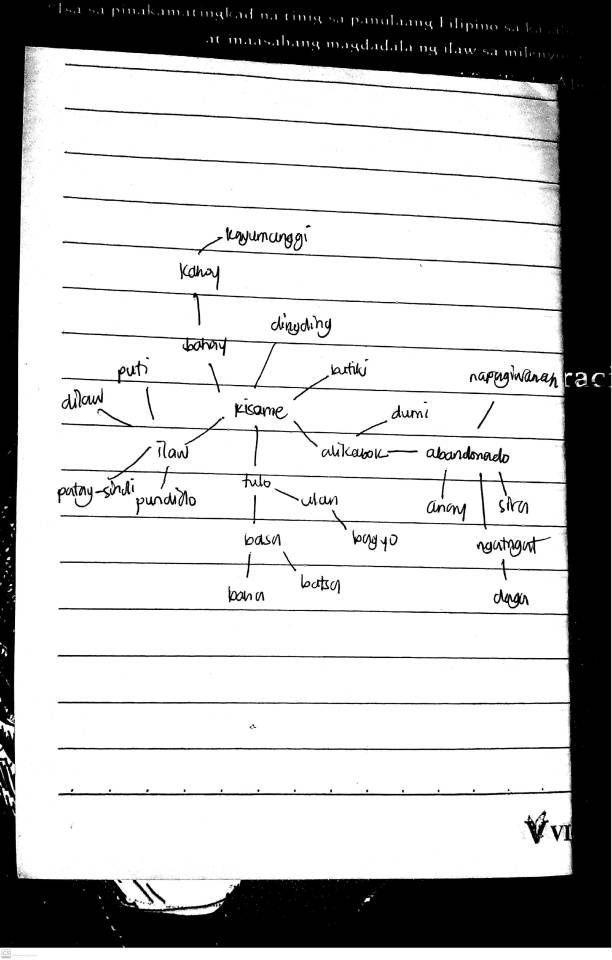
0 notes
Text
Arts 1 | Blog 2 : Pagdalumat : Isang Repleksyon sa Sining sa Kasalukuyan
Sa pagdalumat natin sa nagdaang mga siglo ng pag-unlad at pagbabago ng sining sa Pilipinas, at bilang saksi sa ng sining sa kasalukuyan, ay narito ang aking mga na-obserbahan :
Isko’t Iska 2022 : In the Kapokverse of MADness

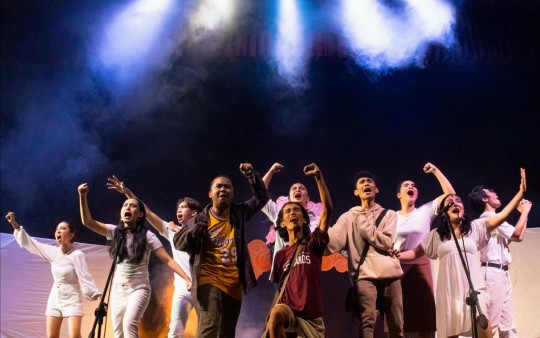
Bilang parte ng produksyon ng taunang Isko’t Iska ay nasaksihan ko bilang aktor ang pagkakapit-bisig ng Umalohokan Incorporated, UPLB Writer's Club, at UPLB University Student Council kasama ang marami pang organisasyong nakiisa para maisulong ang produksyon kasama dito ang mga panawagang nag-uugat sa masa. "Dulang mula sa Masa, Para sa Masa", ito ang pinanghahawakan ng Isko’t Iska sa mahigit apat na dekada nitong pagpapamalas ng talento at pagkalapag sa mga natutulog na diwa, lalo na noon sa lagim na idinulot ng rehimeng Marcos, sa mga nagdaang administrasyon at magpahanggang sa ngayon na nasa posisyon na naman ang isang gahaman at mapang-alipustang nanunungkulan.
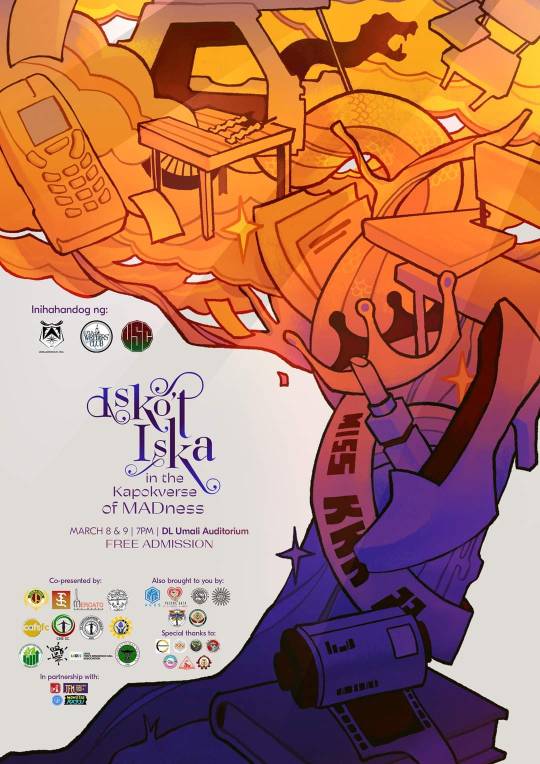
Ang pagtatanghal na ito ay nabuo gamit ang pinagsama-samang mga malawak, makulay, bukas at mapagpalayang mga isipan. Mula sa mga awitin, mga pagsayaw, sa pag-arte, paggalaw ng mga ilaw, dramaturhiya, mga kasuotan at marami pang iba.
Isa sa mga ito ay ang mga kantang isinulat at inawit bilang gabay ni Gab Carreon kasama si Cha Moulic at Meg Guiang.
Ulan, Apoy, at Hangin [Isko't Iska 2022 Song Demos]
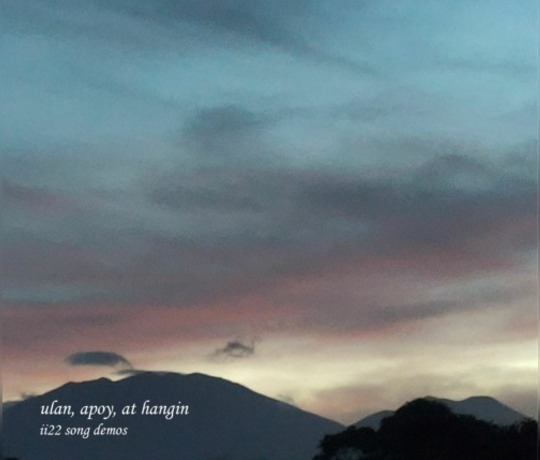
Ang paggamit ng mga hiram at ukay-ukay na damit ay isa rin sa mga paraan upang maging maayos na damit at magkaroon ng pagresaykel at paggamit muli ng mga kasuotang ginamit mula sa mga nakaraang produksyon. Tila nagkaroon pa nga ng ukay-ukay sa Umalohokan, kung saan maaaring mahiraman ng damit na magagamit para sa hinaharap na mga produksyon.
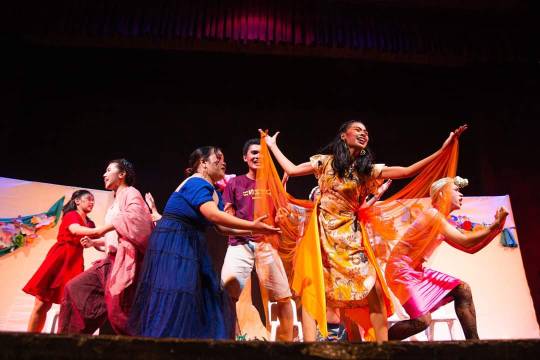
Higit sa lahat ay ang kabuluhan ng nasabing produksyon. Gaya ng workshop namin sa klase kasama ang aming mga kapwa Iskolar na nagmula sa Lumad Bakwit School, ang bawat kulay, luntian, dilaw, at itim na siyang nay kanya kanyang kahulugan, bawat pares na aming hinabi upang makabuo ng kwintas, pulseras at iba pa, ay gayundin ang mga tawag ng tambuli ng mga kontemporaryong suliranin na aming isinulong sa Isko’t Iska. Ang mga pag-atake sa mga Lumad Bakwit Schools sa Pilipinas ay isa sa mga panawagan ng aming mga kapwa Iskolar ng bayan sa naganap na workshop.

Kaya't para sa mga kapwa namin artista ng bayan, mga manonood, mga kultural na organisasyon sa Pilipinas, nawa'y pagtuonan ninyo ng pansin ang pagtampok, pagsuporta at paingayin ang panawagan sa mga kwento at pagtatanghal na may kabuluhan gaya ng mga kapwa natin mula sa Lumad Bakwit School at ng Isko’t Iska.
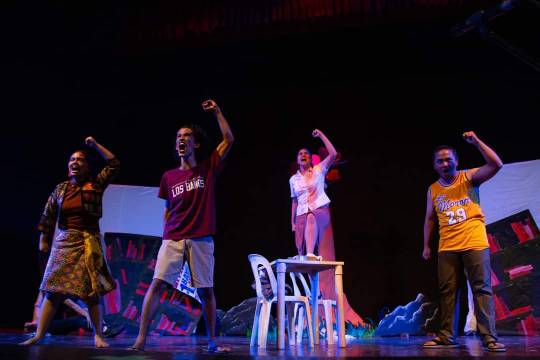
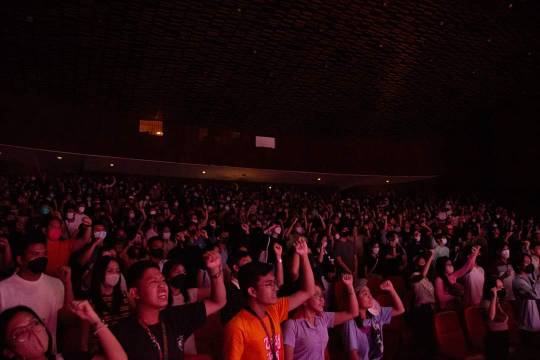
Paumanhin kung aking bukambibig ang Isko't Iska sa inyo, ito lamang talaga ay napakalapit sa aking puso. Sa mahigit tatlong rin kasing nakulong ako sa aming bahay, malayo sa pagtatanghal sa entablado at maging sa kalsada. Unang beses ring naramdaman kong may kahalagahan ang aking itinatanghal.
Kaya't kung hindi mo naabutan ang aming pagtatanghal noong ika-walo at ika siyam ng Marso sa D. L. Umali Auditorium ay huwag madismaya dahil may pre-recorded na pagtatanghal na maaari ninyong mapanuod sa Facebook page ng Isko’t Iska at Youtube Channel ng Umalohokan Incorporated!
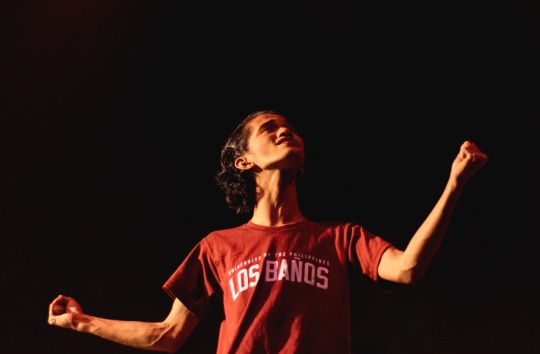
Gaya ng pagsikat at paglubog ng araw sa kahel na langit, patuloy at patuloy pa rin na sisibol ang sining na makahulugan at mapagpalaya!
Artista ng Bayan, Ngayon ay Lumalaban!
Ngayon ay Lumalaban, Artista ng Bayan!
0 notes
Text
BLOG #2: Contributing to the Current Conversations on Philippine Contemporary Arts
Art is beauty for the other, function for another; nevertheless, it is freedom altogether.
Philippine contemporary art encompasses diverse cultures and art forms ranging from a mix of traditional, alternative, and dominant (Tabuena, 2021). The art of the Filipino today still serves both aesthetics and functionality. It shows diversity from creativity in vivid colors and themes of injustices, such as the artworks of Federico Boyd Sulapas Dominguez, where we see his art focuses on the marginalized and socio-ecological issues of today, and the communal perspective of the Filipino culture present in the art of Larry Alcala as a cartoonist and in the art of Filipino cuisine, wherein we find in Halo-halo with all of its colorful sahog as of yesterday's traditional (indigenous) arts, as emphasized by Alice Guillermo.
Contemporary Philippine art can't exist without addressing social realism as a response to the authoritative political milieu under Marcos (Flores & Quijon, n.d.).
Reflecting on it, it's sustainability is weak in terms of human development. We still see the dominance of social realism, consumerism, fascism, and exploitation of the indigenous. From the presentation on the workshop of the Lumad Bakwit School, wherein even the definitions of the colors of the beads were analogous to the many exploitations they've endured, the prominence of injustice is present as they describe the colors in such a way that we, the listeners, understand and hear their struggles against military abuses, as yellow for hope in times when they felt hopeless and red for cooperative resistance against the exploiters. The anti-terror bill in the Philippines made local artists more prone to authoritative abuses, especially those with their beliefs ingrained in art with themes of politics and activism. In mainstream media, especially at the height of the pandemic, we see how Philippine contemporary art portrayed the struggles of our people through representations and activisms in Jadie Regala Pasaylo's "Alay na Ginhawa sa Gitna ng Pandemya" and Neil Doloricon's art prints during the pandemic, such as Pila (2020).

Jadie Regala Pasaylo's "Alay na Ginhawa sa Gitna ng Pandemya"
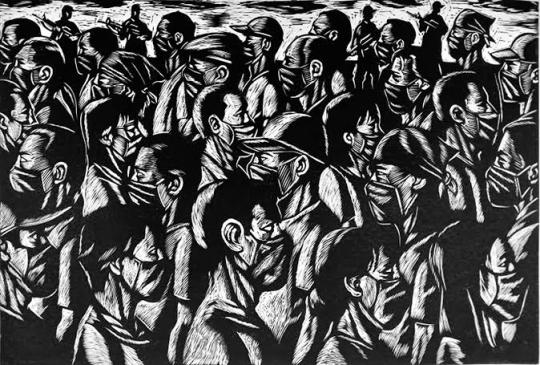
Neil Doloricon's "Pila" (2020)
Our modern arts shouldn't have to suffer so much. It is better if those in authority implement strategies that curators are doing by themselves inside communities excluded from prominent art capitals, such as Manila, and sharing different knowledge and collective experiences in exhibitions such as the Load na Dito project, instead were given the anti-terror bill and exploitation. Thus, accessibility and full public reception is still limited.
However, despite the superficiality of safety in Philippine contemporary art, Filipinos remain in solidarity, especially amid the pandemic and exclusivity of the art scene prominent in the capital. The mobile art and research project Load na Dito was started in 2016 by artist Mark Salvatus and curator Mayumi Hirano. They note the "joint efforts of arts and cultural workers to form a loose structure," describing the art environment in the Philippines as "physically distant but socially intimate, fragmented but connected (Flamingo, 2022)."
References:
Flamingo, J. (2022, April 18). The art scene in the Philippines by Manila-based initiative Load na Dito. Art Curator Grid. https://blog.artcuratorgrid.com/load-na-dito-interview/
Flores, P.D. & Quijon, C. (n.d.). Philippine Art: Contexts of the Contemporary. Aura Asia Art Project. Retrieved May 02, 2023, from https://aura-asia-art-project.com/en/news/philippine-art-contexts-of-the-contemporary/
Tabuena, A. C. (2021). A synthesis overview of the contemporary art forms and performance practices in the Philippines. International Journal of Humanities and Social Science Studies, 7(1), 103-109.
0 notes
Text
in the midst of all the issues regarding the anti-terror bill, please take some time to read about the other issues that persist in the philippines with this carrd website (not mine). there are petitions to sign, information about the jeepney crisis and the lumad school crisis, and links to donations to save lumad schools. please share this around!!
104 notes
·
View notes
Text
On education and development
I decided to watch Emmanuel Macron’s maiden UN General Assembly address and compared to Donald Trump’s apocalyptic, fire-and-brimstone warnings, his chose to inspire. I almost sobbed in one of the libraries in the law school because he started with the war and talked about human rights. He talks about development and education as the solution for radicalism, which our government has not done.
And here, I hope to speak for those without a voice. The Duterte government threatened to bomb schools for indigenous people in the island of Mindanao on the accusation that Communist rebels use them to recruit the locals. (x)(xx) The Department of Education has refuted the accusations, stating that all these schools are registered. (x) Various sectors from all sides of the political spectrum have criticized him, citing the Geneva Conventions, the right of children to education, and the goal to de-escalate military intervention in the area. Radicalism occurs when people feel excluded and are marginalized. The people of Mindanao are far from so-called “Imperial Manila,” where all the wealth is concentrated. Mindanao has long been a hotbed of communist and fundamentalist Muslim insurgency because indigenous people have been pushed away by internal migration, businessmen, and mining companies. Infrastructure is concentrated in Manila and the surrounding areas. People thought that Duterte, the first President from Mindanao, would address these issues in a sensitive way. Instead, he does not create opportunities to remove insurgency in the regions.
In spite of appointing known members of the Communist party and prominent left-leaning members, his relations with them have soured. Almost none of those initially appointed Cabinet members remain in his cabinet. A military operation targeting the indigenous people has not been halted by the President. And now we wonder why radical elements such as the Maute group attacked Marawi. And now we wonder why communists have such a stronghold in the mountains and in the far-flung places. Because government does not reach them. Peace only comes with development and justice. This means making social services (health, education, infrastructure) accessible to all. This means building bridges by removing religious, cultural, and economic stigma instead of perpetuating stereotypes about the Muslims and lumads of Mindanao.
This means seeking peaceful solutions, not waging wars which cause nothing but suffering, poverty, and human rights violations on all sides.
We start with education. It must start with education.
2 notes
·
View notes
Text
GIVE THEM BACK THEIR RIGHTS. GIVE THEM BACK THEIR LANDS. GIVE THEM BACK THEIR POSSESSIONS. GIVE THEM JUSTICE FOR ALL THOSE PRECIOUS LIVES YOU TAKE USING YOUR GUNS WHICH IS FUNDED BY THE TAX OF THE COMMON PEOPLE. GIVE THEM BACK THEIR RIGHT TO EDUCATION.
STOP MARGINALIZING THE LUMAD PEOPLE.

#Philippines#no to martial law#junk terror bill#activism is not terrorism#oustduterte#save lumad schools#fight for freedom#stop taking the rights of the people#dds#rodrigo duterte
348 notes
·
View notes
Text
apparently the indigenous lumad people of lianga refer to the burial of the dead as a planting of the dead instead, and i think that's a powerful sentiment
#especially given the fact that the government kills indigenous farmers children and people so regularly#my heart is with the victims of the recent massacre. may this suffering end soon#like it's so fucked up that most lumad schools are on-the-go schools bc they have to be ready to leave at any given moment#should the military tag them as communists and shoot them
3 notes
·
View notes
Text
On “just google it” mentality
Looking over data has been made easier by search engines in the past few years and with it came the phrase “Just google it.” but I fell that this phrase is being misused by people as of late and I feel that the misuse of this phrase is evident to those who who take technological education, internet access and the opportunity of English mastery for granted.
Having a giant database is going to help us gain knowledge of matters easily but there lies the problem of knowing how to use it. You’d think, ooohh everyone knows how to use a computer and surf through the web but that is actually false. There are still plenty of places where internet and technological access is terrible. So to say, having internet access and the corresponding digital literacy not only to comprehend its use but also to filter and authenticate the items that appear in your search is a learned skill and is a privilege to those of us who have had enough internet access to realize these unspoken rules.

This is the percentage of those with internet access based on the total population in 2017. I cannot speak much for other countries but I can for the Philippines. There are over 100 Million Filipinos and in 2017, that means there are 48 Million Filipinos without internet access. I heard that it has improved as of late and the percentage has risen up to 60.1%. That’s 2.1 Million more Filipinos who gained access in the past three years and that’s a good thing but these 2.1 Million people would have to learn to familiarize themselves with the use of it.
Access doesn’t equate to skills. Perhaps, they only know popularized apps like youtube or facebook or instagram. Knowing your way when surfing through the net isn’t something inborn to us. We learn it, either through schools or through surfing the net for years. And we have to understand that mocking people in the internet and making them feel guilty for being uninformed just doesn’t check out because you don’t know the technological background of this person. Were they taught to be computer literate since young? Did they only get their first smartphone? Do they have unlimited wifi access or are just phone data? Telling your classmate who has held a smartphone the moment it got released in the market to just google it is okay. Telling your thesis partner who has a laptop since forever and obviously has had the opportunities to familiarize with the internet to just google it isn’t a problem. But you can’t analyze someone’s computer and internet literacy as easily here. Not everyone is given the opportunity and the resources to learn about this and maximize its use and I hope that when you meet an uninformed person but are in a position that doesn’t allow you to send your online sources directly, you can tell them about looking over it through the net without sounding like a condescending prick.
(Also, please, if you can, help boost news about the Philippine’s issue with internet and tech problems. The government wants to shift to online learning but refuse to spend for it. It will gravely affect the schooling of Filipinos that lack laptops, ipads/tablets and internet access because we are expected to have these items ourselves. This is a classist attack against the right of the Filipino poor to education. Hashtags on twitter about this are #NoStudentLeftBehind, #AcademicFreeze, and #AcademicFreezeNow.)
There is also the issue about how native English speakers and perhaps those who have gained English mastery take for granted the fact that the internet caters to us.

English dominates the language used for contents in websites. It also is the most commonly used language on the internet, currently at 25%, just around 4% above Chinese. Non-native English speakers especially those who are still mastering the language take effort to comprehend content on the internet. It’s not as simple as ~just googling it~ because you’d need to sometimes translate it or look at a dictionary for help. The internet isn’t tailor-made for us and it requires more effort to adapt to it and maximize its use. So please, the next time you meet an uninformed person, don’t be a condescending prick about it. Inform them if you want to or at the very least direct them properly on how they could inform themselves. You don’t know the digital background of the person you end up conversing with in the internet. The least you could do is not guilt them for being uninformed and lacking the necessary skills that makes informing oneself easier.
#us centrism#philippines#I'm just really tired when people expect you to know everything just because you are in the internet at the moment#like dude that's just a person writing their ramblings in a blog#they aren't writing academic papers or teaching history in schools#reprimanding people for not knowing facts that aren't general knowledge ESP WHEN THEY ARE LIKE KNOWLEDGE ABOUT YOU KNOW ANOTHER COUNTRY just#doesn't sit well with me like god if someone doesn't know that tinalak is from the Tboli people in the Philippines that doesn't mean they#hate indigenous Filipinos If they act though that the lumad killings is justified and the shutting down of lumad schools is okay then that's#a legit fucking asshole of a person#tangina I get you want more people to know about subcultures and that's fun I get so whacked when I see art with Barong tagalog or when#I see art of pre-colonial gods and goddesses#get really whacked when they mention Mariang Sinukuan#or when they use Bakunawa swallowing the moons for a storyline#But please stop treating people as less just because they know less#you don't know the circumstances of them being uninformed about it#you don't get to make them feel guilty for not knowing#mei rambles
40 notes
·
View notes
Text
Hi everyone especially to Filipinos, please take time to check this out, educate ourselves and sign these petitions! We must act NOW, for our own lives, and for our beloved country. Please, allow ourselves to see what our country really needs.
#words#save lumad schools#no to jeepney phaseout#pilipino#pilipinas#philippines#junk terror bill#junk terror bill now#mass testing now#mass testing#petition#donations#halalan2022
6 notes
·
View notes
Text
don't know if this is on tumblr already but sharing this masterlist docs of links, emails, petitions, and donation sites concerning
anti-terrorism bill (ph)
black lives matter movement
hong kong autonomy
covid-19 & quarantine
defending press freedom (ph)
extrajudicial killings (ph)
saving lumad schools (ph)
jeepney phaseout (ph)
https://docs.google.com/document/d/13zeIs_QH-26x2bBHSNzE6OJS9x3x0YFsU_C9HOmVklE/edit
#stay safe#stay informed#do what we can#anti terrorism bill#ph#philippines#blm resources#hong kong#hong kong autonomy#covidquarantine#covid19#covid 19#quarantine#press freedom#defend press freedom#ejk#extrajudicial killings#save lumad schools#jeepney phaseout#masterlist
1 note
·
View note
Photo

to be human is to speak for those who are silenced.
#photography#portrait photography#portrait#protest#march#demonstration#fujifilm#fuji#fujifilm xt20#save lumad schools#save lumad#protect our lumads#philippines#ph#ust#2018#arch of the centuries#instagram#ig#digital photography#digital#camera#fujiph#fujiphotography#my post#lumad#documentation#peaceful protest#peaceful
0 notes